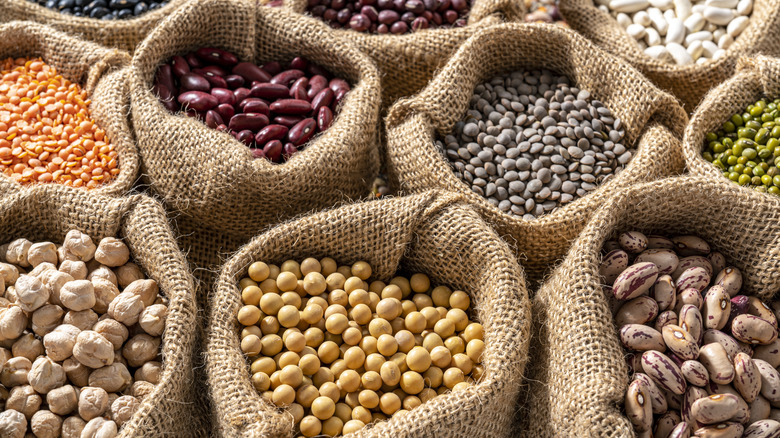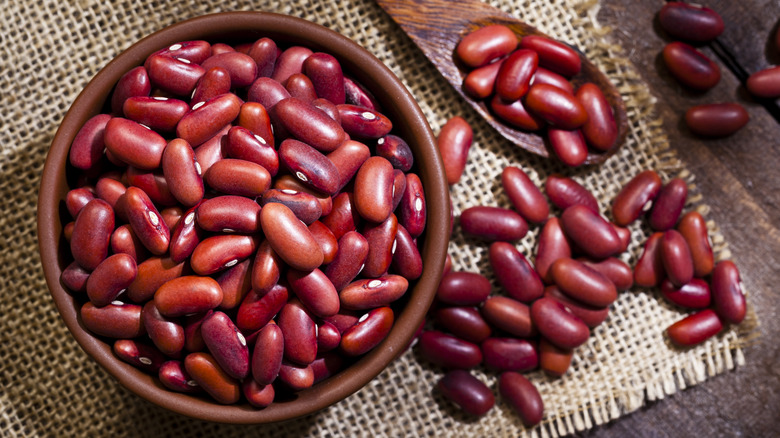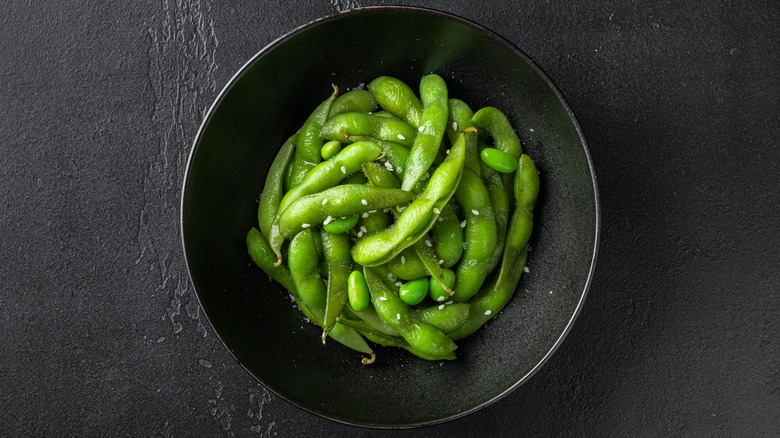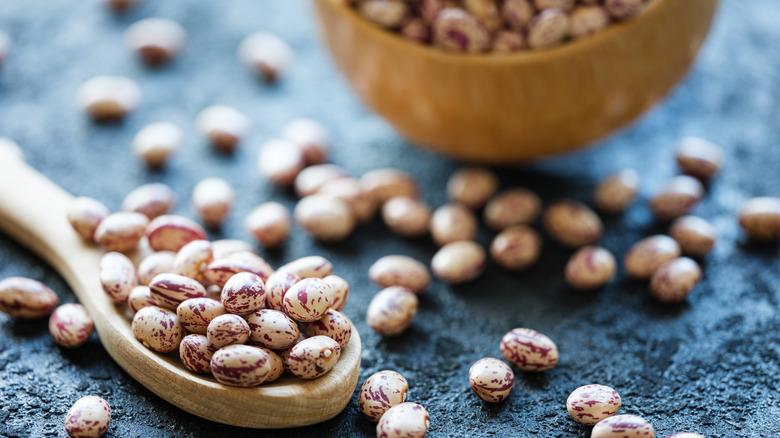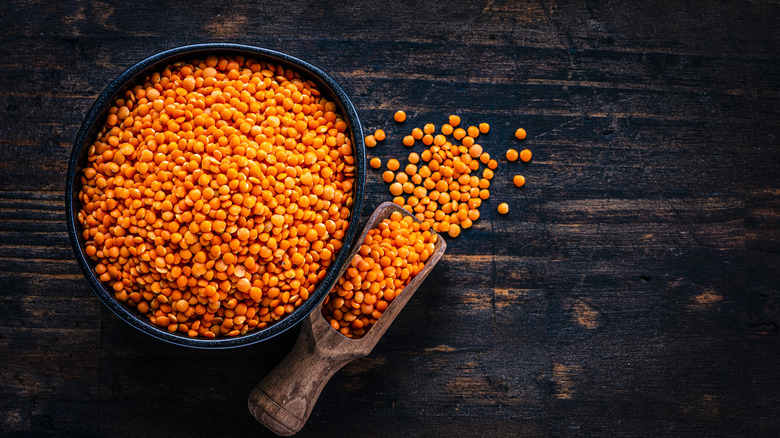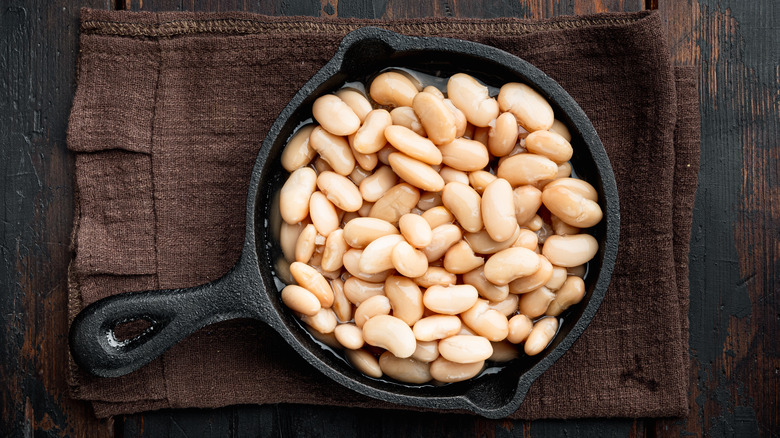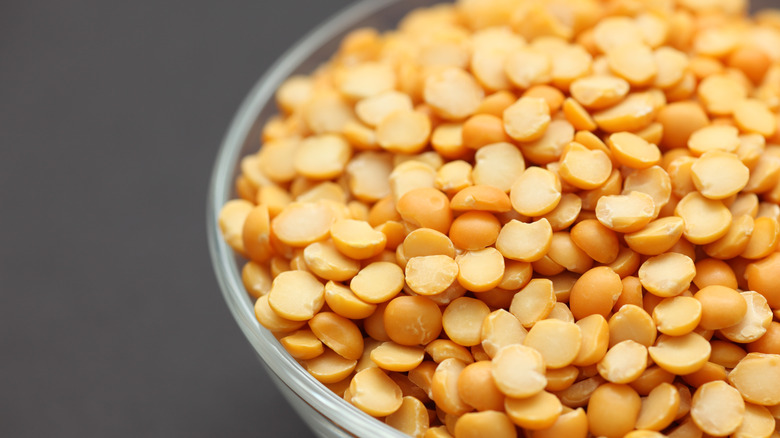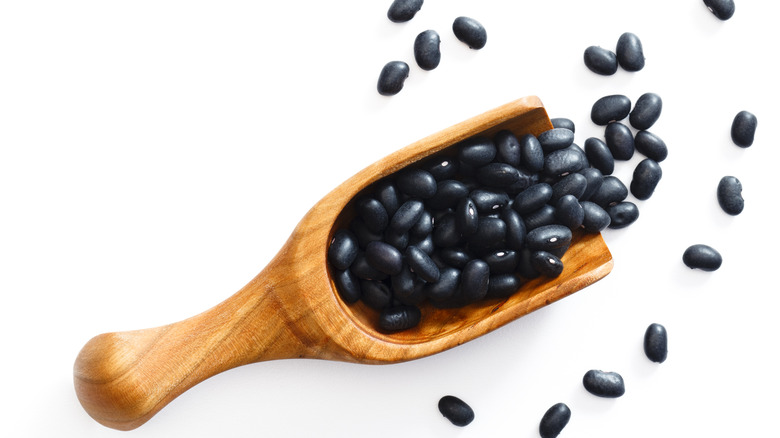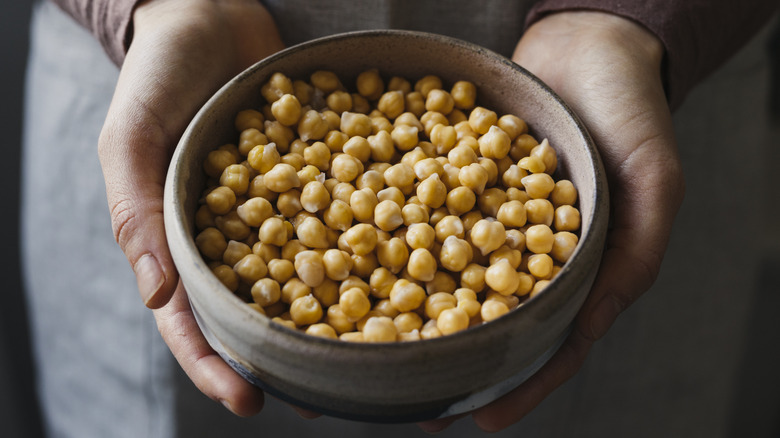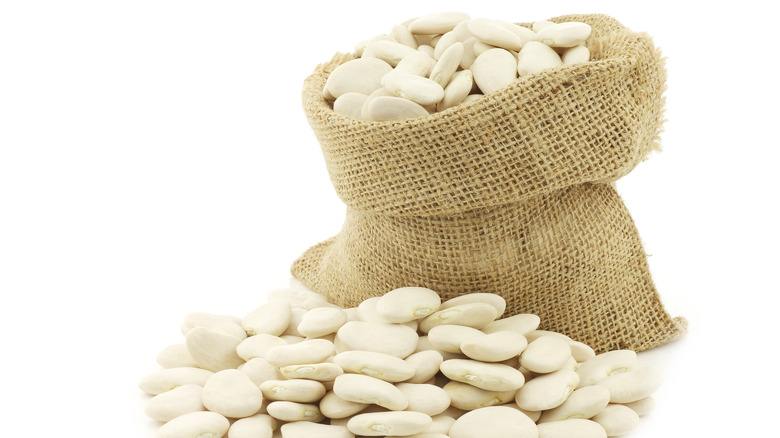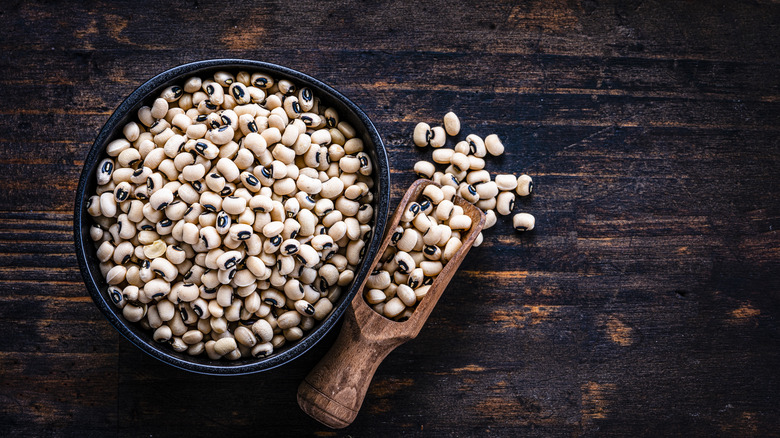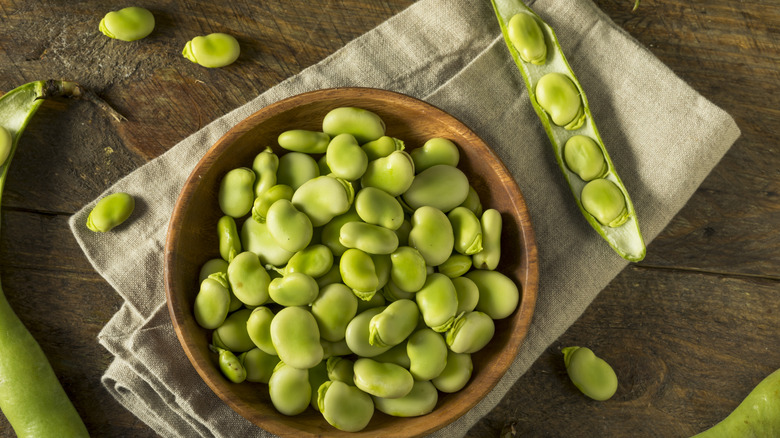Vegetables That Have More Protein Than A Glass Of Milk
When thinking of vegetables, most usually think of broccoli, carrots, spinach, or kale. Likewise, many automatically jump to meat, chicken, milk, or fish when thinking of protein. However, while the conventional spotlight often gravitates towards animal-derived sources, you could also rely on a vast number of high-protein veggies to reach your body's protein goals, which, according to a study published in the Journal of Sports Science and Medicine, are meant to help you build muscle, repair tissues, and produce enzymes and hormones.
According to the U.S. Department of Agriculture's (USDA) My Plate, vegetables are categorized into five distinct subgroups based on nutrient content and their diverse array of health benefits. One of the said subgroups is comprised of beans, peas, and lentils, which defies traditional classifications by joining both vegetable and protein food groups. Per the USDA, these plant-based champs not only fulfill protein requirements in a similar fashion as meat and poultry, but they also deliver a great deal of dietary fiber and other essential nutrients typically deficient in the American diet, which is why they also made the cut into the vegetable food group. This article delves into the unexpected world of vegetables that surpass the protein content in a glass of milk, revealing a series of potent protein contributors within the vegetable kingdom.
Vegetable protein vs. milk protein
When it comes to protein, there's a difference between plant-based and animal-based sources. Per a 2020 study published in Nutrients, animal sources like milk, eggs, and beef are considered complete proteins because they provide all the essential amino acids your body needs to grow and develop. On the other hand, plant proteins may lack certain amino acids and, thus, are deemed incomplete proteins. For example, vegetables like beans, peas, and lentils often fall short in sulfur-containing amino acids like methionine and cysteine. But here's the thing: According to the study, you can still get all the amino acids you need from these vegetable sources by eating a variety of them.
In fact, vegetables like beans, peas, and lentils are fantastic plant-based protein options that pack more protein per cup compared to the eight grams of the nutrient provided by the same amount of milk (via the USDA Food Data Central). Plus, not only do they give you protein, but they also offer tons of fiber, a nutrient that's virtually non-existent in milk. Therefore, while milk is a good source of protein, plant options can be just as effective, which challenges the idea that animal proteins are the only way to get all the nutrients you need.
Kidney beans
Kidney beans are a well-known member of the common bean family because they seamlessly blend versatility with health benefits. Available in light red and dark red varieties, these beans stand out by packing an impressive 15 grams of protein per cup (via the USDA Food Data Central), almost twice as much protein as a cup of milk. But, beyond their protein punch, kidney beans contribute significantly to your health. According to WebMD, these beans aid in the reduction of blood cholesterol levels. Plus, the high fiber content in these beans not only makes them an ally in weight management but also positions them as potential guards against colon cancer. Lastly (but definitely not least), their low Glycemic Index (GI) ensures that they don't cause abrupt spikes in blood sugar levels, making them a wise choice for people with diabetes or those looking to manage their blood sugar.
When it comes to adding them to your diet, kidney beans offer a spectrum of possibilities. For instance, they add a hearty texture and protein boost to dishes that would otherwise lack those qualities, such as salads and soups, and they work as a delicious side dish to almost any meal. Incorporating kidney beans into your daily menu is as easy as mixing them with colorful vegetables, herbs, and a zesty dressing for a nutritious and satisfying salad or pairing them with whole grains, veggies, and your favorite sauce for a nourishing bowl.
Edamame
Edamame, the vibrant green bean among vegetable proteins, is actually whole, immature soybeans with a nutritional appeal worthy of an award. For starters, compared to a cup of milk, a one-cup serving of cooked edamame offers a robust 18 grams of protein (via the USDA Food Data Central), making it one of the vegetables with the highest protein content on this list. But that's not all. According to a study published in the Journal of Sports Science and Medicine, soybeans are considered complete proteins despite being a vegetable protein, meaning that the quality of edamame's proteins is the same as milk's proteins.
Yet, protein aside, edamame earned its reputation as a wholesome addition to any diet by also being rich in fiber, vitamins, and minerals. In fact, it provides an impressive 121% of the Daily Value (DV) for folate, a vital mineral essential for DNA synthesis and maintaining healthy red blood cells (via the National Institutes of Health (NIH)). Finally, when it comes to health benefits, research links edamame intake to a reduced risk of breast and prostate cancers. Plus, it is associated with reduced bone loss and menopausal symptoms, all while contributing to blood sugar and cholesterol control (per Healthline). One of edamame's biggest culinary appeals is that it seamlessly integrates into various dishes. You can enjoy it as a savory snack for a satisfying and nutritious munch, add it to soups, salads, or stir-fries for an extra boost of protein and a burst of vibrant color, or even pureé it to prepare a creamy and protein-packed alternative to traditional spreads.
Pinto beans
With a generous offering of 15 grams of protein per cup (via the USDA Food Data Central), pinto beans double the amount of protein in a cup of milk, standing as a protein-packed powerhouse among legumes. Moreover, these beans' health benefits include promoting heart health, playing a role in blood sugar control, supporting proper digestion, fostering gut health, and even contributing to weight loss (via Healthline). In addition, the site explains that their health-promoting appeal is further enhanced by the presence of antioxidants, including polyphenols and flavonoids, which act as cellular guardians against free radical damage.
Pinto beans have a mild flavor and creamy texture, making them a perfect canvas for various dishes. For example, a classic Mexican trio featuring pinto beans, tortillas, and guacamole not only creates a delightful snack or appetizer but also provides a substantial protein source, as evidenced by a study published in The Journal of Nutrition. Other ways to enjoy pinto beans on a daily basis include adding them to salads or burritos, incorporating them into a warm and hearty soup like this 5-Bean soup, opting for them as your bean of choice for a wholesome pinto bean chili, or preparing a smooth and nutritious dip perfect for snacking by blending them with garlic, olive oil, and spices.
Lentils
Small but mighty, lentils are distinguished by their diverse colors, textures, and flavors, offering a broad range of options for when you feel like exploiting your culinary creativity. For example, you can find brown lentils, which maintain their firmness when cooked; green lentils, which boast a nutty taste and also hold a firm texture; red lentils, which offer a mild and sweet flavor while turning soft upon cooking; and black lentils (also known as Beluga lentils), which resemble caviar in appearance (per the Cleveland Clinic).
Yet, beyond their colorful culinary charm, lentils serve as potent health allies. According to a review published in the International Journal of Molecular Sciences, numerous studies link lentil consumption to a reduced risk of diseases such as diabetes, obesity, cancer, and heart issues, attributing these benefits to the legume's bioactive compounds, notably antioxidants and fiber. And adding to their nutritional repertoire, lentils prove to be excellent sources of potassium and iron (via the Cleveland Clinic). Potassium contributes to lower blood pressure, while iron helps prevent anemia. When it comes to protein, they boast an impressive 18 grams per cup (via the USDA Food Data Central), making them the second highest-protein-containing vegetable on this list. Remarkably, unlike many other beans, lentils don't require overnight soaking, streamlining their preparation process and making it far easier to incorporate them into your weekly menu in the form of lentil soup, curry, salad, stew, or even lentil patties for a vegetable protein-rich alternative to traditional burgers.
White beans
White beans, commonly recognized as cannellini beans or white kidney beans, have a tender texture and a delightfully earthy and nutty flavor. Compared to milk's eight grams of protein per cup, white beans are packed with a substantial 17 grams of protein in the same serving (via the USDA Food Data Central), meaning that this bean variety stands out as an exceptional addition to a high-protein, dairy-free diet. Plus, they offer an excellent source of fiber, along with essential nutrients such as copper, folate, and iron. Moreover, according to Healthline, white beans have a high nutrient density mixed with a relatively low calorie content, making them a valuable ally for those seeking to support a healthy body weight. In fact, per a review published in Nutrients, bioactive compounds extracted from white beans may inhibit an enzyme called alpha-amylase and, thus, limit the digestion and absorption of carbs, reinforcing the beans' beneficial effect on body weight and metabolic health.
Incorporating white beans into your diet proves effortless owing to their mild flavor, making them a versatile ingredient in an array of recipes. From hearty stews and soul-warming soups to robust chilis and comforting casseroles, the culinary possibilities are vast. Embracing white beans in your weekly repertoire not only elevates the flavor of your meals but also contributes to a well-rounded and protein-rich diet.
Split peas
While often underestimated in the world of legumes, split peas take center stage with compelling health benefits and diverse culinary applications. For starters, they boast an impressive 16 grams of protein per cup (via the USDA Food Data Central), which is nothing short of double the protein content of milk. But it doesn't end there for split peas, seeing that their micronutrient content is just as impressive. For instance, their high fiber content grants them the potential to manage blood sugar levels, improve digestion and gut health, and help maintain a healthy body weight. Plus, split peas are rich in antioxidants, including beta-carotene, selenium, manganese, and zinc, which combat free radicals and, thus, help reduce the risk of cancer and heart disease (per Healthy Huemans). Notably, the beta-carotene content contributes not only to the vegetable's nutritional profile but also supports eye health (via the NIH).
With various types available, including green, yellow, and red, split peas offer a spectrum of flavors and applications in culinary endeavors that go beyond a simple soup, and incorporating them into your diet is both simple and delightful (thanks to the fact that you don't have to soak them overnight to cook them). For example, red and yellow split peas are perfect for creamy curries and filling salads. In contrast, the green ones make a good side dish of split pea mash, which you can easily do by mashing the cooked peas and mixing them with garlic, herbs, and a drizzle of olive oil.
Black beans
Celebrated for their rich flavor, nutritional density, and meaty texture, black beans are a staple ingredient in Central American households and vegan and vegetarian cookbooks, and with good reason. Packed with a substantial 15 grams of protein per cup (via the USDA Food Data Central), black beans outshine milk in the protein department, making them an excellent plant-based protein source. Plus, not only do they contribute to protein intake, but they also boast natural attributes that promote heart health and blood sugar control. According to Medical News Today (MNT), black beans are low in sodium and rich in potassium, calcium, and magnesium, which collectively contribute to lowering blood pressure naturally. Additionally, the fiber in black beans helps lower blood cholesterol levels, reducing the risk of heart disease.
However, the beans' fiber benefits extend to blood sugar control, as a study published in Nutrients revealed that pairing black beans with high-Glycemic Index (GI) foods, such as white rice, mitigates the spike in blood sugar levels after a meal. Therefore, adding black beans to your diet is not just a culinary delight but also a strategic move toward bolstering your overall health. Since they have become so popular among plant-based dieters, there are numerous creative ways to add black beans into your meals, including black bean tacos or burgers for a plant-based alternative to American staples and black bean brownies for those looking for a protein-packed treat.
Chickpeas
Chickpeas, also known as garbanzo beans, are another versatile veggie that seamlessly integrates into a myriad of dishes. Starting with their protein content, a cup of boiled chickpeas packs a generous 14 grams of protein (via the USDA Food Data Central). But that's not all. According to the Cleveland Clinic, chickpeas are classified as a complete protein, which means that, like milk, they contain all nine essential amino acids crucial for optimal bodily function.
Yet, the health benefits of chickpeas go beyond their protein profile. One of the standout features of chickpeas is their high fiber content, which not only aids in weight control but also contributes to alleviating constipation and managing blood sugar levels. Moreover, Healthline suggests that chickpeas may reduce the risk of chronic illnesses such as heart disease, cancer, and type 2 diabetes, which can be attributed to their rich combination of fiber, protein, and a spectrum of essential nutrients. Due to their nutty taste and grainy texture, chickpeas are pretty much culinary chameleons that seamlessly adapt to numerous creations, enhancing both flavor and nutritional quality. For example, you can include chickpeas in your main dishes by preparing a chickpea curry, stew, or salads, enjoy them as a crunchy or creamy snack by either roasting them or making hummus, or even have them as a sweet treat, such as these peanut butter chickpea cookies.
Lima beans
Lima beans are flat, cream-colored, kidney-shaped beans that serve as nutritional powerhouses while bringing a delicate texture and mild flavor to the table. Moreover, according to WebMD, beyond their culinary appeal, lima beans prove to be a nutrient treasure trove. Starting with their soluble fiber content, these beans facilitate the slow digestion of carbs, which prevents blood sugar spikes. At the same time, their insoluble fiber acts as a prebiotic, or food for the friendly bacteria in your gut, contributing to digestive health. In addition, lima beans are a rich source of iron and polyunsaturated fatty acids, playing a crucial role in preventing anemia and heart disease, respectively. And let's not forget about their impressive protein count, which stands at 15 grams per cup once boiled (via the USDA Food Data Central).
In the culinary realm, lima beans prove to be versatile and accessible year-round, offering a convenient and nutritious addition to various dishes. If you're looking for exciting ways to add lima beans to your diet, try incorporating cooked lima beans into your favorite stir-fry, combining them with colorful vegetables and your preferred seasonings, or swapping the traditional chickpeas for lima beans the next time you're whipping up homemade hummus.
Black-eyed peas
Black-eyed peas, named for their distinctive appearance, offer a delightful combination of flavor and nutrition to any diet. You can easily distinguish black-eyed peas from other peas and beans thanks to their cream-colored exterior, which is adorned with a small black dot in the center (which is what gives them that eye-like look). Yet, nutritionally speaking, they do resemble other beans and legumes. For example, they also pack a punch of protein, standing out with a commendable 12 grams per cup (via the USDA Food Data Central). In addition, black-eyed peas also contribute to digestive health, promoting regular bowel movements through their rich fiber content (via MNT).
However, per MNT, one of the standout features of black-eyed peas is their unique beta-carotene content, a nutrient that the body converts into vitamin A and is crucial for maintaining healthy vision and glowing skin. Adding black-eyed peas to your diet is really simple, seeing that their nutty flavor pairs well with a range of ingredients. For instance, they're a popular ingredient in the world of soups, curries, and stews, giving those comforting dishes a nutritional boost. However, they are also favored in salads, where you can take a closer look at their unique appearance.
Fava beans
Fava beans are vibrant green legumes that come enclosed in pods and are not only rich in protein but also offer additional health benefits. Starting with their 13 grams of protein per cup (via the USDA Food Data Central), they surpass milk's protein content by five grams, highlighting their value when it comes to meeting dietary protein needs. Moreover, they shine as a rich source of folate, with one cup meeting almost half of the daily folate needs (via the Food and Drug Administration (FDA)). Per the NIH, folate is a vital vitamin that plays a pivotal role in DNA production. Additionally, fava beans are believed to offer health effects such as potentially improving motor function, boosting immunity, and promoting digestive health due to their high vitamin, mineral, fiber, and antioxidant content (per Healthline).
Beyond their many benefits, fava beans contribute to an overall healthy diet with a slightly sweet, earthy flavor that enhances various dishes. If you're looking for new ways to add fava beans to your diet, try roasting them for a tasty and crunchy snack, or elevate your soup game by incorporating fava beans, spinach, and spices for a comforting and nutrient-rich dish.


